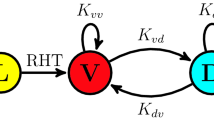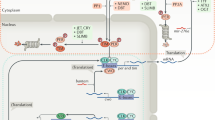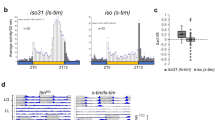Abstract
The role of circadian rhythmicity in photoperiodic processes in plants and animals is still poorly understood. Involvement of circadian rhythmicity in photoperiodism has been demonstrated for a number of plants1,2, two mammals3,4, a number of birds5,6, and some species of insects7–11. Three theoretical alternatives have been suggested with regard to the form this involvement may take, with emphasis on the possibility that the circadian system is concerned with photoperiodic time measurement12–14. Most of the evidence for the involvement of the circadian system in both plant and animal photoperiodism comes from experiments with nondiel photoperiods—light/dark cycles with period lengths other than 24 h. The experimental design which has been used most frequently is the so-called resonance technique, in which the light component of a light/dark cycle is held constant and the dark component is varied over a wide range in successive experiments, to provide cycles with period lengths up to 72 h or more. Rhythmic variations in the photoperiodic response with peaks about 24 h apart are evidence for the involvement of circadian rhythmicity in the photoperiodic process studied. However, in some plants1, a reptile15, and a number of insect species16–20, the resonance technique failed to demonstrate any influence of circadian rhythmicity on photoperiodism. Using the same technique we have now found a rhythmic response in the incidence of diapause in the common spider mite, Tetranychus urticae, thus showing that in mites also, circadian rhythmicity is involved in the photoperiodic reaction.
This is a preview of subscription content, access via your institution
Access options
Subscribe to this journal
Receive 51 print issues and online access
$199.00 per year
only $3.90 per issue
Buy this article
- Purchase on Springer Link
- Instant access to full article PDF
Prices may be subject to local taxes which are calculated during checkout
Similar content being viewed by others
References
Vince-Prue, D. Photoperiodism in Plants (McGraw-Hill, London, 1975).
Bollig, I., Chandrashekaran, M. K., Engelman, W. & Johnsson, A. Int. J. Chronobiol. 4, 83–96 (1976).
Elliott, J. A., Stetson, M. H. & Menaker, M. Science 178, 771–773 (1972).
Grocock, C. A. & Clarke, J. R. J. Reprod. Fert. 39, 337–347 (1974).
Gwinner, E. in Avian Biology (eds Farmer, D. S. & King, J. R.) 221–285 (Academic, New York, 1975).
Gwinner, E. & Eriksson, L.-O. J. Orn., Lpz. 118, 60–67 (1977).
Saunders, D. S. J. Insect Physiol. 19, 1941–1954 (1973).
Saunders, D. S. J. Insect Physiol. 20, 77–88 (1974).
Beach, R. F. & Craig, G. B. Jr J. Insect Physiol. 23, 865–870 (1977).
Dumortier, B. & Brunnarius, J. C. r. hebd. Séanc. Acad. Sci., Paris 285, 361–364 (1977).
Thiele, H. U. Oecologia 30, 331–348 (1977).
Bünning, E. Ber. dt. bot. Ges. 54, 590–607 (1936).
Pittendrigh, C. S. Proc. natn. Acad. Sci. U.S.A. 69, 2734–2737 (1972).
Pittendrigh, C. S. in The Neurosciences Third Study Program (eds Schmitt, F. O. & Worden, F. G.) 437–458 (MIT, Massachusetts, 1974).
Underwood, H. J. comp. Physiol. 125, 143–150 (1978).
Peterson, D. M. & Hamner, W. M. J. Insect Physiol. 14, 519–528 (1968).
Pittendrigh, C. S. & Minis, D. M. in Biochronometry (ed. Menaker, M.) 212–250 (National Academy of Sciences, Washington, 1971).
Lees, A. D. J. Insect Physiol. 19, 2279–2316 (1973).
Skopik, S. D. & Bowen, M. F. J. comp. Physiol. 111, 249–259 (1976).
Bonnemaison, L. Z. ang. Ent. 86, 178–204 (1978).
Veerman, A. J. Insect Physiol. 23, 703–711 (1977).
Saunders, D. S. Insect Clocks (Pergamon, Oxford, 1976).
Bünning, E. Die physiologische Uhr (Springer, Berlin, 1977).
Vaz Nunes, M. & Veerman, A. J. comp. Physiol. 134, 203–217 (1979).
Vaz Nunes, M. & Veerman, A. J. comp. Physiol. 134, 219–226 (1979).
Lees, A. D. Ann. appl. Biol. 40, 449–486 (1953).
Lees, A. D. Ann. appl. Biol. 40, 487–497 (1953).
Author information
Authors and Affiliations
Rights and permissions
About this article
Cite this article
Veerman, A., Nunes, M. Circadian rhythmicity participates in the photoperiodic determination of diapause in spider mites. Nature 287, 140–141 (1980). https://doi.org/10.1038/287140a0
Received:
Accepted:
Issue Date:
DOI: https://doi.org/10.1038/287140a0
This article is cited by
-
Physiological and molecular mechanisms underlying photoperiodism in the spider mite: comparisons with insects
Journal of Comparative Physiology B (2016)
-
Circadian rhythmicity is involved in photoperiodic time measurement in the aphidMegoura viciae
Experientia (1993)
-
The photoperiodic clock and counter mechanism in two species of flies: evidence for damped circadian oscillators in time measurement
Journal of Comparative Physiology A (1988)
-
Insect photoperiodism: the linden bug,Pyrrhocoris apterus, a species that measures daylength rather than nightlength
Experientia (1987)
-
Analysis of the operation of the photoperiodic counter provides evidence for hourglass time measurement in the spider miteTetranychus urticae
Journal of Comparative Physiology A (1987)
Comments
By submitting a comment you agree to abide by our Terms and Community Guidelines. If you find something abusive or that does not comply with our terms or guidelines please flag it as inappropriate.



